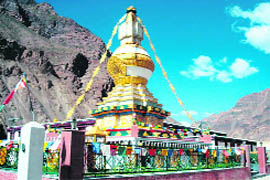 For over 1000 years, the Tabo Monastery, located in the remote Spiti valley of the trans-Himalayan frontier region, has weathered many a storm. Considered to be the oldest continuously functioning Buddhist monastery in India, Tabo is now showing signs of wear and tear due to the heavy precipitation in the Spiti valley — a new phenomenon ushered in by global climate change. It is ironic that the monastery, which has weathered harsh and extreme weather conditions in the largely snow-bound valley falling in a cold desert, is now falling prey to the increased moisture because of the heavy-rain phenomenon. The mud walls and exquisite thangka paintings of the monastery are in danger as moisture seepage threatens to widen the ever-increasing cracks due to intense rainfall.
For over 1000 years, the Tabo Monastery, located in the remote Spiti valley of the trans-Himalayan frontier region, has weathered many a storm. Considered to be the oldest continuously functioning Buddhist monastery in India, Tabo is now showing signs of wear and tear due to the heavy precipitation in the Spiti valley — a new phenomenon ushered in by global climate change. It is ironic that the monastery, which has weathered harsh and extreme weather conditions in the largely snow-bound valley falling in a cold desert, is now falling prey to the increased moisture because of the heavy-rain phenomenon. The mud walls and exquisite thangka paintings of the monastery are in danger as moisture seepage threatens to widen the ever-increasing cracks due to intense rainfall.
“In the recent past, the area has witnessed much more rainfall than ever before, leading to the problem of water seepage and high moisture levels inside the mud structure,” says Chettan Zangpo, assistant to the head of the monastery, Geshe Sonam Wangdu. He says the mud walls having beautiful paintings are developing cracks due to moisture, which could lead to their final destruction. “A heritage which we have saved for 1,000 years should not be lost to rain. The steps taken by the Archaeological Survey of India (ASI) seem insufficient as the cracks are still appearing,” he says. Pointing towards the paintings of the Buddha on the wall, he shows the cracks while observing that the colours, too, are fading gradually.
The Tabo Monastery, which traces its existence to 996 AD, has been under the Archaeological Survey of India for its preservation and upkeep. The ASI officials admit that the increased rainfall, hitherto unknown during the summer or monsoons, is causing a lot of problems, forcing them to use tarpaulin sheets to prevent the seepage, leading to damage of the ancient mud structure.
Those in charge of the monastery point out that the use of tarpaulin sheets between the mud layers is adding to the problem as it prevents the moisture from escaping on its own. They say if this is not stopped, the wooden structures in the monastery could also face damage.
The ancient monastery of Tabo in Spiti Valley has survived harsh climate, including heavy snowfall that the cold desert experiences, but now it seems to be falling a victim to the climatic changes. “Like all other places, Tabo, too, has witnessed much more rainfall, negligible till a few years back, which is probably why the ancient structure faces a threat from climate change,” admits Manmohan Singh, Director, local Meteorological Centre. The monastery, which is frequented by a large number of tourists, foreign as well as domestic, has priceless idols and paintings inside the main complex as well as in the caves. The caves, one main and 30 smaller ones in the mountains overlooking the monastery, house the rarest of the rare thangka paintings, which are not open to the public. These are used by monks for rigorous meditation and spiritual quest only occasionally. With the provision for natural light, electricity, too, is not used inside the main temple of the monastery, lest it causes damage due to sharp light. Special care is taken to ensure that there is no damage on account of other things like strong flashlights of the cameras or loud sounds. “We are very particular in what we do here, as there is no way we would want the monastery to suffer even the smallest damage. But much more needs to be done to save it from rain,” says Norbu Thayes, principal of Serkong School attached to the monastery.
Judy and Michael from America are simply fascinated by the Tabo Monastery, where they have spent a week. “We can’t get enough of the place as every nook and corner has a history to it,” says Judy, as she clicks to capture the thangkas, murals and, of course, the breathtakingly beautiful landscape against the crystal clear blue sky, kissed by the snow-capped peaks.
With immense potential for tourism in the area, the launch of the much awaited heli-taxi service to provide connectivity to the far-flung tribal areas would help in attracting more visitors, especially the high-end ones, who wish to explore the virgin areas.
With its incredible beauty and rich cultural heritage, Tabo marked its millennium celebrations in 1996, which coincided with the Kalchakra initiation. The Serkong Rabsal Buddhist Culture Society at Tabo is engaged in preserving the rich cultural heritage for the future generations. The thrust is on reviving traditional songs, dance forms, music and popularising the Bhoti language among the younger generation.
Source: The Sunday Tribune




